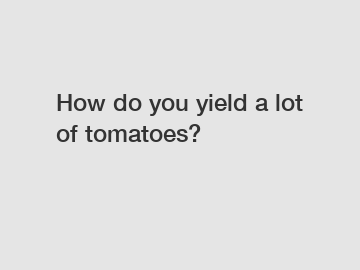Dec. 20, 2023
Agriculture
Google Hot Topics: How do you yield a lot of tomatoes?
Point 1: Choosing the right tomato variety.
When aiming to yield an abundance of tomatoes, selecting the right variety is crucial. Tomato plants come in various forms, such as determinate and indeterminate. Determinate varieties tend to have a fixed height and set fruit all at once, making them suitable for canning or preserving. On the other hand, indeterminate tomatoes continue to grow and produce fruit throughout the season, resulting in a prolonged harvest. Consider your preferences and requirements before deciding between determinate and indeterminate varieties. Additionally, research the best tomato varieties for your climate zone, disease resistance, and desired taste.

Point 2: Providing optimal growing conditions.
Tomatoes thrive in specific conditions, and tailoring their environment can significantly impact their productivity. These plants require a minimum of six to eight hours of direct sunlight per day, so select a well-drained spot in your garden that receives ample sunlight. Rich, loamy soil with good drainage is ideal for healthy tomato growth. Test your soil's pH and ensure it falls between 6.0 and 6.8 for optimal nutrient absorption. If needed, amend the soil with organic matter, such as compost or aged manure, to improve its texture and fertility.
Point 3: Proper watering techniques.
Watering tomatoes correctly is vital to ensure good yields. Maintaining consistent moisture levels is crucial, as both under and over-watering can negatively affect the plants. Aim to provide approximately 1-1.5 inches of water per week, either through rainfall or irrigation. However, it's equally essential to avoid waterlogged soil, which can lead to root rot. Consider using a drip irrigation system or a soaker hose, as these methods deliver water directly to the plants' roots, reducing the risk of fungal diseases. Mulching around the base of the plants can help preserve soil moisture, regulate temperature, and deter weeds.
Point 4: Supporting your tomato plants.
Further reading:Tomato plants tend to sprawl and can become unruly without proper support. Providing support not only prevents the plants from toppling over but also helps maximize air circulation and sunlight exposure to the foliage, reducing the risk of diseases. There are several support options, like cages, stakes, or trellises. Choose a method that suits your preferences and the size of your tomato plants. As the plants grow, gently tie the main stem to the support structure using soft plant ties or twine. Be careful not to tie the stems too tightly, allowing room for growth.
Point 5: Pruning and removing suckers.
Pruning and removing suckers is a contentious topic among tomato enthusiasts. Suckers are the small shoots that develop in the leaf axils of tomato plants. Some gardeners prefer to prune suckers to improve air circulation and redirect the plant's energy towards fruit production. However, others leave the suckers intact, believing they contribute to more extensive foliage and eventual higher yields. Experiment and find your preferred approach; however, note that heavy pruning can reduce the plant's overall leaf area and potentially expose fruit to sunburn. Indeterminate varieties generally benefit more from pruning, while determinate ones may not require extensive pruning.
Point 6: Proper fertilization and nutrient management.
Supplying your tomato plants with adequate nutrients is paramount to achieving abundant yields. Before planting, incorporate a balanced slow-release fertilizer into the soil. As the plants grow, side-dress them with a nitrogen-rich fertilizer every few weeks. Regularly monitor the leaves for any nutrient deficiencies, indicated by yellowing or discoloration, and address the issue promptly. Organic options like compost or compost tea can provide essential micronutrients to support plant health. However, be cautious not to over-fertilize, as excessive nitrogen can result in vigorous foliage growth at the expense of fruit production.
Conclusion:
Growing a bountiful tomato harvest requires careful planning, attention to detail, and implementing best practices. By selecting the most suitable tomato variety, optimizing growing conditions, providing proper support and water, and managing pruning and nutrients effectively, you can increase your tomato yield significantly. Experimentation and adapting techniques to your unique circumstances will lead you to find what works best in your garden. So, roll up your sleeves, put on your gardening gloves, and enjoy the satisfaction of harvesting an abundant crop of delicious tomatoes.
If you want to learn more, please visit our website bulk red skin radish, sorghum seeds suppliers, Chinese Celery Seeds For Sale.
Further reading:Previous: Unlocking Maximum Cooling Efficiency: Air Inlet Louvers for High-Performing Cooling Towers
Related Articles
If you are interested in sending in a Guest Blogger Submission,welcome to write for us!
All Comments ( 0 )